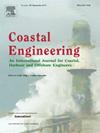Wave kinematics-based bathymetry estimates from satellite optical video
IF 4.5
2区 工程技术
Q1 ENGINEERING, CIVIL
引用次数: 0
Abstract
In this work, cBathyShortDwell, a version of the spectral depth inversion algorithm cBathy that has been adapted for shorter record lengths, was applied to four 29.9-60s satellite-based optical videos and the resulting bathymetry estimates were compared to bathymetry surveys collected within 13 days of each satellite collect. The Planet SkySat videos were collected at the U.S. Army Engineer Research and Development Center Field Research Facility between April and September 2023. The videos were collected at 30Hz with a ground sampling pixel resolution of 0.75-1 m and an image size of approximately 2.5km x 1km. RMSEs from post-processed cBathyShortDwell depth estimates over the 800 m x 1100 m analysis domain using the entire video duration at a 5 Hz frame rate ranged from 0.50 to 0.59 m with biases ranging from -0.19 to 0.16 m. Although some differences were seen in the RMSEs as a function of frame rate (2 to 30 Hz), larger differences were observed due to video length (17-60s), wave visibility in the imagery, and incident wave conditions. The highest overall RMSEs were observed in conditions with short video lengths (RMSE ranging from 0.76–1.32 m for all post-processed bathymetry estimates generated with 17-s videos) or conditions with low wave visibility (RMSE 0.80–0.99 m and 0.32-0.59 m for all post-processed bathymetry estimates using 30s videos with low wave visibility). These results are comparable to published RMSE values from established versions of the algorithm (Holman et al., 2013, Holman and Bergsma, 2021) and demonstrate the ability of cBathyShortDwell to provide good depth estimates from satellite videos in a range of environmental conditions.
基于卫星光学视频的波浪运动学测深估计
cBathyShortDwell 是光谱深度反演算法 cBathy 的一个版本,适用于较短的记录长度,在这项工作中,cBathyShortDwell 被应用于四段 29.9-60 秒的星基光学视频,并将得出的水深估计值与每次卫星采集后 13 天内收集的水深测量结果进行了比较。Planet SkySat 视频于 2023 年 4 月至 9 月期间在美国陆军工程研发中心野外研究设施收集。视频采集频率为 30Hz,地面采样像素分辨率为 0.75-1 m,图像大小约为 2.5km x 1km。在 800 m x 1100 m 的分析区域内,使用 5 Hz 帧频的整个视频时长进行 cBathyShortDwell 深度估计的后处理均方根误差在 0.50 到 0.59 m 之间,偏差在 -0.19 到 0.16 m 之间。虽然均方根误差与帧频(2 到 30 Hz)有一些差异,但由于视频长度(17 到 60 秒)、图像中的波浪能见度以及入射波条件的不同,差异较大。在视频长度较短(所有使用 17 秒视频生成的后处理水深估算值的有效误差范围为 0.76-1.32 米)或波浪能见度较低的条件下(所有使用波浪能见度较低的 30 秒视频生成的后处理水深估算值的有效误差为 0.80-0.99 米,偏差为 0.32-0.59 米),观察到的总体有效误差最大。这些结果与已公布的算法版本的 RMSE 值相当(Holman 等,2013 年;Holman 和 Bergsma,2021 年),证明了 cBathyShortDwell 能够在各种环境条件下通过卫星视频提供良好的深度估计值。
本文章由计算机程序翻译,如有差异,请以英文原文为准。
求助全文
约1分钟内获得全文
求助全文
来源期刊

Coastal Engineering
工程技术-工程:大洋
CiteScore
9.20
自引率
13.60%
发文量
0
审稿时长
3.5 months
期刊介绍:
Coastal Engineering is an international medium for coastal engineers and scientists. Combining practical applications with modern technological and scientific approaches, such as mathematical and numerical modelling, laboratory and field observations and experiments, it publishes fundamental studies as well as case studies on the following aspects of coastal, harbour and offshore engineering: waves, currents and sediment transport; coastal, estuarine and offshore morphology; technical and functional design of coastal and harbour structures; morphological and environmental impact of coastal, harbour and offshore structures.
 求助内容:
求助内容: 应助结果提醒方式:
应助结果提醒方式:


